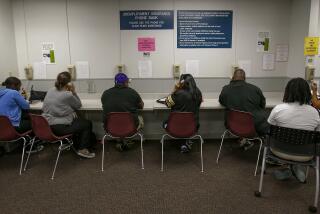June’s job losses, 467,000, are an economic shocker
WASHINGTON — After four straight months of encouraging signs, the nation’s unemployment picture has unexpectedly darkened -- a sobering jolt to hopes that the economy was getting back on track.
The unemployment rate edged up just a notch in June, to a 26-year high of 9.5%, the government reported Thursday. But the loss of 467,000 payroll jobs made it clear that the worst economic crisis since the Great Depression was far from over.
Not only was the size of the payroll loss unexpected, it reversed a trend in which the monthly losses had been steadily shrinking from the January peak of 741,000 jobs eliminated. Those declines had raised hopes that an actual turnaround might be approaching.
No longer.
“The green shoots in the job market are hard to find,” said Sung Won Sohn, an economist at Cal State Channel Islands in Camarillo.
Cutbacks came across virtually every major industry, Sohn noted.
The latest report means that since the recession began in December 2007, the ranks of the unemployed have almost doubled to 14.7 million, and that nonfarm employers have eliminated 6.5 million jobs.
The grim numbers dragged down stock markets around the world, with the Dow Jones industrial average falling 223.32 points, or 2.6%, to 8,280.74.
The report also gave Republican politicians fresh ammunition to criticize President Obama’s $787-billion economic stimulus program as ineffective in creating jobs.
In a measure of just how bad the employment situation has become, the Economic Policy Institute in Washington said the current economic decline had erased the accumulated payroll growth of the last nine years.
“This is the only recession since the Great Depression to wipe out all the jobs growth from the previous business cycle,” institute economist Heidi Shierholz said.
Obama administration officials called for patience and vowed to do whatever was necessary to revive the economy and the labor market.
“We’re going to keep doing everything we can to offset the pain and set this economy up for a robust expansion,” said Jared Bernstein, chief economist and economic policy advisor to Vice President Joe Biden.
Bernstein said he saw one large positive sign in the Labor Department’s monthly report: With the June numbers, the pace of job losses for the second quarter as a whole had fallen to 436,000 a month, on average, down from an average monthly contraction of 691,000 jobs in the first quarter.
But other analysts, including many on Wall Street, looked at it differently. Since January, when monthly job losses peaked, the pace of payroll cuts had moderated through May, when employment fell by a revised 322,000.
Analysts had expected the economy to lose about 350,000 jobs in June.
The renewed acceleration in job losses contrasted with a batch of recent economic reports that signaled improvements in various parts of the economy, including housing and manufacturing.
A separate government report Thursday, for instance, showed that factory orders in May increased by the largest amount in nearly a year.
Unemployment is always a lagging indicator, and many economists still expect the economy to start growing again this year. But the latest jobs report offers evidence that the labor market could remain sluggish for months or years to come.
The unemployment rate for men reached 10%. The jobless figure for women was 7.6%.
The figures would have been higher were it not for a drop in the number of people participating in the job market, including discouraged workers who have dropped out of the labor force because they don’t think they can find jobs.
Of particular concern, the number of long-term unemployed -- those out of work for 27 weeks or more -- swelled by 433,000 last month to 4.4 million, the report said. This group now represents 29% of unemployed workers.
“This is going to be a bigger and bigger social problem going into next year,” said David Card, a labor economist at UC Berkeley.
Employers in every major sector ratcheted up the job cuts last month, with the exception of health and education services, which added 34,000 jobs over the month.
Manufacturing employment continued to sink, dropping an additional 136,000 positions, as the battered auto industry and related transportation industry contracted.
The construction industry cut 79,000 jobs last month and is down 1 million jobs from a year earlier, masking job gains from some 2,000 projects in the Obama Recovery Act that already have been launched.
Even government, which had been one of the bright spots in this recession, thinned its rolls by 52,000 jobs. That was partly because of an end to temporary work at the Census Bureau. But with many states, notably California, grappling with budget problems, the government is no longer a haven.
The latest report suggested that fresh college graduates would face a grim labor market, and it would be a particularly long, tough slog for unemployed workers. Although their jobless benefits have been extended, in many cases up to a year, there are few signs that employers are hiring. The temporary-help industry, often considered a leading indicator of future hiring, was down 37,600 jobs in June.
Among other worrisome indicators, the average weekly hours of work in June dropped a notch to 33, a record low, reflecting shortened work hours and furloughs at some firms. Involuntary part-time employment continued to climb. This means that employers, when they feel confident enough to hire again, will first give more work to existing employees before adding new staff.
The Obama administration has been trying to help workers by increasing funding for unemployment benefits and job training, on top of its massive economic stimulus spending.
Still, economists widely expect the jobless rate to reach double digits this year and stay high well into next year, even as economic growth turns positive later this year.
--
More to Read
Inside the business of entertainment
The Wide Shot brings you news, analysis and insights on everything from streaming wars to production — and what it all means for the future.
You may occasionally receive promotional content from the Los Angeles Times.










